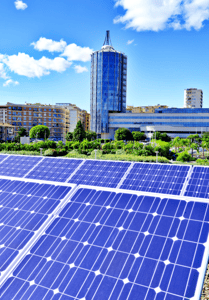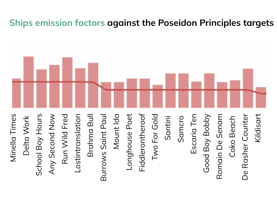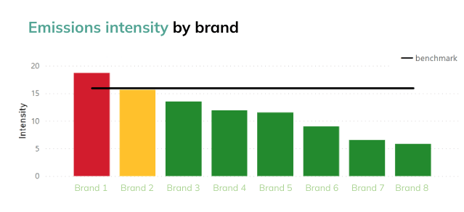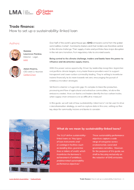Over half of the world’s greenhouse gas (GHG) emissions come from the global commodities market1. Commodity traders and their lenders are therefore central to the climate challenge. Their supply chains and portfolios face major disruption in the net-zero transition, from regulatory risks to stranded assets.
Being central to the climate challenge, traders and banks have the power to influence and decarbonise supply chains.
With this power comes opportunity. Driven by leadership recognition, legislation and portfolio climate targets, many trade finance providers want to support transparent and lower-carbon commodity trading. They’re willing to incentivise traders financially to do more towards net zero, encouraging the pursuit of ambitious transition strategies.
Yet there’s a barrier: a huge data gap. It’s complex to track the production, processing and flow of agricultural and extractive commodities, let alone the emissions created. How can banks and traders identify the low-carbon trades, when supply chain emissions are so difficult to measure?
In this guide, we will look at how sustainability-linked loans2 can be used to drive a decarbonisation strategy, as well as capture data in this area, setting out five key steps for commodity traders and banks to consider.
 What do we mean by sustainability-linked loans?
What do we mean by sustainability-linked loans?
The SLLP define sustainability-linked loans as “Any types of loan instruments and/or contingent facilities (such as bonding lines, guarantee lines or letters of credit) which incentivise the borrower’s achievement of ambitious, predetermined sustainability performance objectives“.
These sustainability performance objectives capture a wide range of categories across environmental, social and governance activities. However, for the purposes of this guide, we shall be focusing exclusively on the reduction of GHG emissions.
(1) Measure
As the saying goes, ‘If you don’t measure it, you can’t manage it’. So, Step 1 is to fill the data gap with a GHG emissions inventory, and understand the existing carbon impact of the trader’s portfolio.
This carbon accounting should be comprehensive, covering:
- all trades across at least a 12-month period, even if the exercise begins with a sample;
- the end-to-end supply chain for each trade (including production, processing and transport-related emissions, from mine to port and beyond);
- asset-level breakdowns across the supply chain, to build up accurate trade-level calculations as well as to pinpoint the biggest emissions sources;
- all GHG emissions (calculated as carbon dioxide equivalent: CO2e); and
- a summary of emissions intensity as well as absolute emissions.
Accuracy is important. Broad-based estimates won’t do, as you need to be able to compare performance between similar trades and traders (which can vary hugely) and identify granular changes in performance over time. Imprecise estimates also cloud carbon hotspots, hiding the biggest carbon risks. Primary data should be used wherever possible, or precise estimates from verified sources, along with a transparent methodology aligned with the GHG Protocol.
Apart from being the first step to unlocking sustainable finance opportunities, measuring emissions has extra benefits for commodity traders. It reveals how supply chains will be impacted by new regulations like the EU CBAM, and helps traders meet reporting requests and requirements.
(2) Benchmark
Next, it’s time to contextualise the data.
Traders need to map emissions intensities, as well as absolute emissions, against relevant benchmarks. These could include:
- industry standards and guidelines;
- external ratings or metrics;
- industry averages, to assess performance relative to peers; and/or
- pre-existing green finance standards set by the bank.
To ensure the insights are actionable and valuable, benchmarking should be done:
- per asset, trade, vessel and commodity, to pinpoint carbon hotspots and existing low-carbon solutions; and
- across all commodities, to assess performance of the whole portfolio against peers, global standards or existing emissions-reduction targets.


(3) Set the targets
The next step is for the trader to look ahead. The trader needs to present, and the bank needs to agree on, an overarching climate vision and goal, together aligning on what the trader should achieve to unlock the economic benefits of entering a sustainability-linked loan.
This should be translated into sustainability performance targets (SPTs), as measured by corresponding key performance indicators (KPIs). The scope of trades covered, and time frames, should be defined. Traders can use GHG inventory and benchmarking data, as well as any existing goals, such as science-based targets.
The SLLP require that KPIs be material to the borrower’s core sustainability and business strategy, and address relevant environmental, social and/or governance challenges of the industry sector, indicating real, meaningful steps towards decarbonisation. SPTs should be set in good faith and remain relevant (so long as they apply) throughout the life of the loan, encouraging ambitious, positive change.
For example: The average emissions intensity of the trader’s steel portfolio will reduce by 15% in the 12-month period from 1st January 2023 – 31st December 2023, compared to the baseline year.
When setting SPTs relating to KPIs for emissions reductions, traders should consider:
- whether to use emissions intensity, absolute emissions or both as an indicator;
- including a KPI for each commodity to reflect each distinct industry standard and reduction potential;
- including specific and ambitious SPTs focused on the most polluting commodities, to ensure highest impact;
- covering their whole portfolio, rather than just the bank’s financed trades (to ensure SPTs for financed trades cannot be met by switching finance sources for high-emitting trades); and
- feasibility, such as product changes required, business model transformation, and time frames.
KPIs for emissions reductions (absolute and intensity-based) should be achieved without the use of offsets, in order to align with the GHG mitigation hierarchy. However, traders may decide to compensate for remaining emissions through the purchase of credible carbon offsets, as an additional term of the loan, or with the money the trader saves when accessing discounts.
The roll-out of sustainable trade finance is still nascent, with no well-established market standards. This presents a significant opportunity for leadership in setting ambitious emissions-reduction goals.
(4) Seal the deal
The KPIs and SPTs should be clearly documented in the loan agreement, ensuring the economic characteristics of the sustainability-linked loan are clearly defined. Parties might agree to govern how savings should be spent (for example, invested back into value chain climate action), but this is for commercial consideration to be decided on a case-by-case basis.
Parties should ensure the loan agreement covers:
- the verified baseline or science-based reference point selected for improvement of KPIs;
- how the performance against SPTs will be tracked (for example, in-house or through a consultant or carbon accounting software provider?); and
- how traders are to evidence that calculations are accurate, i.e. who will verify the data? Is the third-party provider’s methodology validated as aligned with the GHG Protocol?
Of fundamental importance is ensuring all five components of the SLLP are covered, being:
- Selection of KPIs
- Calibration of SPTs
- Loan characteristics
- Reporting
- Verification
(5) Track and review
Tracking should be done on an ongoing basis, so that the trader can assess the impact of supplier changes and make further interventions. When calculating emissions at the end of the time frame, traders should use the same methodology and approach as used to determine the baseline, to ensure it’s comparable. If using a different methodology (for example, due to improved methodological standards or better access to data) this should be reported with an explanation.
Traders can use their emissions reductions to meet customer demand and access further opportunities in their net-zero journey.
References
1 Fossil fuels account for 73% of the world’s greenhouse gas emissions (Climate Watch dashboard data). According to the United Nations Environment Programme’s Global Environment Outlook, 2019, the extraction and processing of materials, fuels and food are responsible for 50% of global carbon dioxide emissions.
2 As supported by the LMA, APLMA and LSTA’s Sustainability-Linked Loan Principles (SLLP) and supporting Guidance.

Save this guide as a PDF
- Coinsmart. Europe’s Best Bitcoin and Crypto Exchange.Click Here
- Platoblockchain. Web3 Metaverse Intelligence. Knowledge Amplified. Access Here.
- Source: https://www.carbonchain.com/blog/how-to-set-up-a-sustainability-linked-loan




